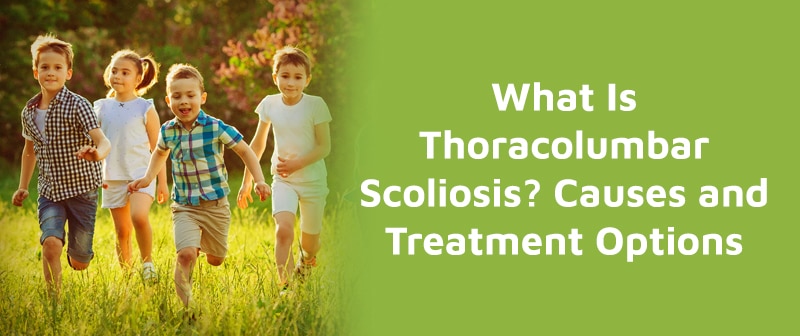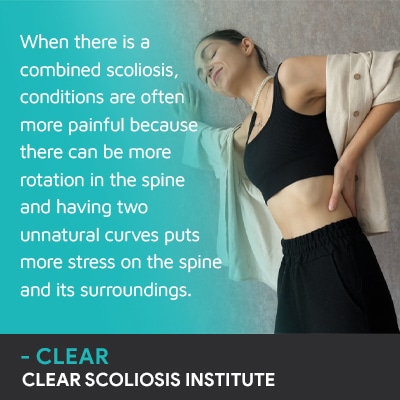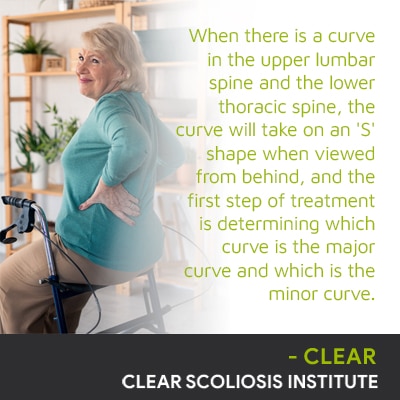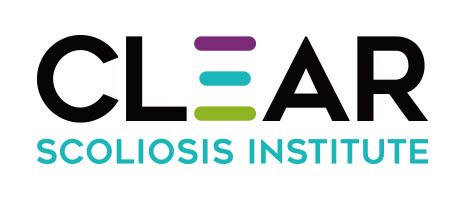
Scoliosis can develop in any of the spine's main sections, or in more than one section. As a progressive condition, being proactive with treatment is key. The goal of treatment is to prevent progression by correcting the unnatural spinal curve's structural nature.
Scoliosis causes the spine to bend and twist unnaturally. Thoracolumbar scoliosis is a common type of scoliosis that develops in the upper lumbar spine and the lower thoracic spine, where the thoracic and lumbar spinal sections meet; it's a combination of thoracic scoliosis and lumbar scoliosis.
A diagnosis of thoracolumbar scoliosis means an unnatural spinal curve that bends to the side and rotates has developed in two of the spine's main sections.
There are three main spinal sections known as the cervical spine, the thoracic spine, and the lumbar spine, and in some cases, scoliosis can develop in more than one section as a combined scoliosis.
The cervical spine refers to the neck; it has to be strong enough to support the weight of the head, turn the head easily, and connects the brain to the spine and the rest of the body,
Thoracolumbar scoliosis develops in the lower thoracic spine (middle/upper back) and the upper lumbar spine (lower back).
Scoliosis is progressive, so the unnatural sideways bend and twist in the spine is likely to get worse over time.
Scoliosis progression is triggered by growth, which is why a diagnosis of childhood scoliosis should always be taken seriously and responded to proactively.
In most cases, we don't know what causes the initial onset of scoliosis.
Most cases of scoliosis involve idiopathic scoliosis with no known cause, and this type accounts for approximately 80 percent of known cases.
Idiopathic scoliosis curves are typical and bend to the right, away from the heart, and in atypical cases, curves can bend to the left, towards the heart; these types are associated with known causes.
The most prevalent type of scoliosis overall is adolescent idiopathic scoliosis, and this age group is also the most at risk for rapid progression due to pubescent growth spurts.
Neuromuscular scoliosis can be particularly severe and is caused by the presence of a larger neuromuscular condition like spina bifida, muscular dystrophy, or cerebral palsy.
Cases of neuromuscular scoliosis can be challenging to treat as the scoliosis has a cause, so the cause has to be addressed to impact the scoliosis.
Congenital scoliosis is a rare type that babies are born with due to the spine not forming properly in utero and vertebrae malformation, and degenerative scoliosis is the fourth main type of scoliosis and affects older adults.
Degenerative scoliosis is most often diagnosed in females over 45 and is caused by degeneration occurring in the spine; the spine, like the rest of the body, is subject to natural age-related degenerative changes.
Causation is a key factor that treatment plans are shaped around, along with patient age, condition severity, and curvature location; these factors also shape a patient's symptoms.
Symptoms of scoliosis will vary from patient to patient. Not only are there different types, there are also different severity levels.
Condition severity is determined by a measurement known as Cobb angle that involves drawing intersecting lines from the tops and bottoms of the curve's most-tilted vertebral bodies, and the higher the Cobb angle, the further out of alignment the spine is, and the more severe the scoliosis.
Scoliosis ranges from mild scoliosis to moderate scoliosis and severe curves. And as a progressive condition, where a patient's scoliosis is when it's diagnosed doesn't mean it will stay at that level, particularly when growth is occurring.
So progression means more noticeable symptoms, and common symptoms of scoliosis include postural changes, movement changes, and pain.
Common postural changes include uneven shoulders, hips, and as the thoracic spine is the only spinal section attached to the rib cage, the development of a rib cage arch is also common.
Pain, however, is more closely associated with adult scoliosis than childhood scoliosis because the condition doesn't become compressive until skeletal maturity has been reached.
Compression is what causes most pain associated with scoliosis; it can involve the muscles, the back, and nerve pain.
In most cases, the spinal section affected, and the area around it, is going to feel the majority of its direct effects, so in cases of thoracolumbar scoliosis, it's the lower back and middle torso that are going to be the most affected.
Movement changes can also be expected as the condition's uneven forces disrupt the body's symmetry; balance, coordination, and gait can also be disrupted.
In adults for whom scoliosis is compressive, lower and middle back pain is common, as is pain that radiates into the extremities due to nerve compression.
For example, a common effect of scoliosis that develops in the lumbar spine is sciatic nerve pain as the sciatic nerve starts in the lower back, and if the unnatural bend and twist in the spine is exposing the sciatic nerve to uneven pressure, it can become irritated, inflamed, and/or impinged and cause symptoms felt anywhere along the nerve's pathway: throughout the lower body.

So while pain levels can vary, adult thoracolumbar scoliosis tends to involve muscle, back, and nerve pain.
When more than one spinal section develops scoliosis, there is more than one unnatural spinal curve and is known as a double curve.

The major curve is larger and more severe and is the focus of treatment as the minor curve is likely a compensatory curve; the spine can respond to the development of an unnatural spinal curvature by adding another unnatural spinal curve that bends in the opposite direction to counteract the first curve's uneven forces.
Here at the CLEAR Scoliosis Institute, the treatment response is proactive and integrative. We want to start treatment immediately following a diagnosis because this is when conditions are at their mildest and most responsive.
As scoliosis chiropractors, treatment is conservative and chiropractic-centered, and the primary goal is addressing the structural nature of the unnatural spinal curves.
Manual adjustments and a variety of chiropractic techniques are applied to work towards adjusting the curve's most-tilted vertebrae so they are more aligned with the rest of the spine.
Once the spine's structure is being impacted, there is physical therapy and scoliosis exercises that work towards improving the spine's surrounding muscle strength and balance for optimal support and stability for the spine.
Physical therapy and scoliosis-specific exercise can also help with postural awareness and restoration so the patient is aware of how to hold their spines and bodies during movement; this helps sustain treatment results and is better for general spinal health.
When treating adolescent idiopathic scoliosis, corrective bracing can be helpful as growing spines are more responsive to bracing treatment.
Rehabilitation can involve custom-prescribed scoliosis-specific exercises patients can continue to perform from home.
While there is also surgical treatment for thoracolumbar scoliosis that involves spinal fusion, the procedure is invasive and can negatively affect the spine's long-term health.
Thoracolumbar scoliosis is a spinal condition that causes an unnatural sideways-bending spinal curve that also rotates to develop, and it develops as a combined scoliosis in the upper lumbar spine and the lower thoracic spine.
The lumbar spine refers to the lower back, and the thoracic spine refers to the middle/upper back.
In cases of a combined scoliosis, the major and minor curves are determined, and the larger curve is the focus of treatment.
Common symptoms of thoracolumbar scoliosis can include postural changes such as uneven shoulders, hips, a rib cage arch, movement changes, and pain is usually more common and severe in adult patients.
While there are no treatment guarantees, the earlier treatment is started, the more effective nonsurgical treatment can be, and this can mean helping patients avoid the challenges associated with increasing condition severity and the need for invasive surgical treatment.
So whether a patient is diagnosed with a single or a combined scoliosis, the best time to start treatment is immediately following a diagnosis as there is a direct link between early diagnosis and the success of conservative treatment.

CLEAR provides a unique and innovative way of understanding scoliosis. Sign up to receive facts and information you won’t find anywhere else.
